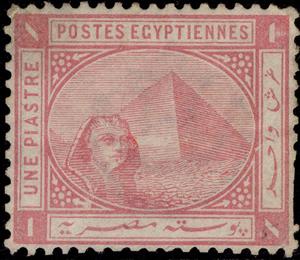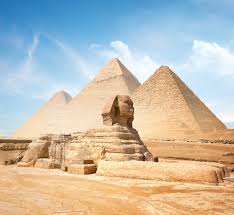Stamp: Sphinx in front of Cheops pyramid (Egypt 1879)
Sphinx in front of Cheops pyramid (Egypt 1879)
01 April (Egypt ) within release Sphinx in front of Cheops pyramid goes into circulation Stamp Sphinx in front of Cheops pyramid face value 1 Egyptian piastre
| Stamp Sphinx in front of Cheops pyramid in catalogues | |
|---|---|
| Stanley Gibbons: | Sg: EG 47a |
Stamp is square format.
Also in the issue Sphinx in front of Cheops pyramid:
- Stamp - Sphinx in front of Cheops pyramid face value 5;
- Stamp - Sphinx in front of Cheops pyramid face value 10;
- Stamp - Sphinx in front of Cheops pyramid face value 20;
- Stamp - Sphinx in front of Cheops pyramid face value 1;
- Stamp - Sphinx in front of Cheops pyramid face value 2;
- Stamp - Sphinx in front of Cheops pyramid face value 5;
- Stamp - Sphinx in front of Cheops pyramid face value 5;
- Stamp - Sphinx in front of Cheops pyramid face value 1;
Stamp Sphinx in front of Cheops pyramid it reflects the thematic directions:
Archaeology or archeology[a] is the study of human activity through the recovery and analysis of material culture. The archaeological record consists of artifacts, architecture, biofacts or ecofacts, sites, and cultural landscapes. Archaeology can be considered both a social science and a branch of the humanities. It is usually considered an independent academic discipline, but may also be classified as part of anthropology (in North America – the four-field approach), history or geography
A monument is a type of structure that was explicitly created to commemorate a person or event, or which has become relevant to a social group as a part of their remembrance of historic times or cultural heritage, due to its artistic, historical, political, technical or architectural importance. Examples of monuments include statues, (war) memorials, historical buildings, archaeological sites, and cultural assets. If there is a public interest in its preservation, a monument can for example be listed as a UNESCO World Heritage Site. The Palgrave Encyclopedia of Cultural Heritage and Conflict gives the next definition of monument:
Myth is a genre of folklore consisting primarily of narratives that play a fundamental role in a society. For scholars, this is very different from the vernacular usage of the term "myth" that refers to a belief that is not true. Instead, the veracity of a myth is not a defining criterion
A pyramid (from Ancient Greek πυραμίς (puramís) 'pyramid') is a structure whose visible surfaces are triangular and converge to a point at the top, making the shape roughly a pyramid in the geometric sense. The base of a pyramid can be of any polygon shape, such as trilateral or quadrilateral.
The United Nations Educational, Scientific and Cultural Organization (UNESCO; pronounced /juːˈnɛskoʊ/) is a specialized agency of the United Nations (UN) with the aim of promoting world peace and security through international cooperation in education, arts, sciences and culture. It has 194 member states and 12 associate members,as well as partners in the non-governmental, intergovernmental and private sector. Headquartered in Paris, France, UNESCO has 53 regional field offices and 199 national commissions





